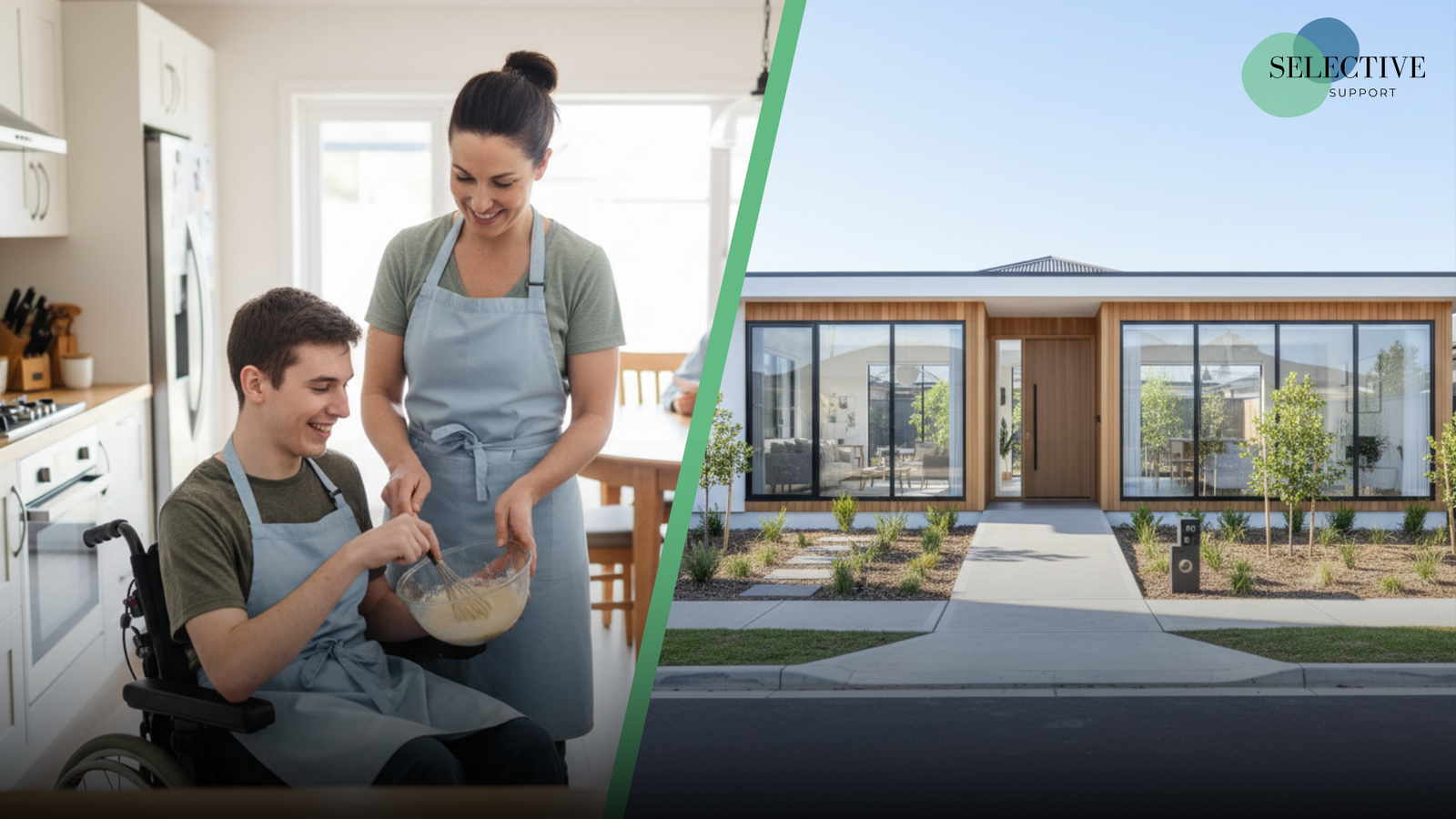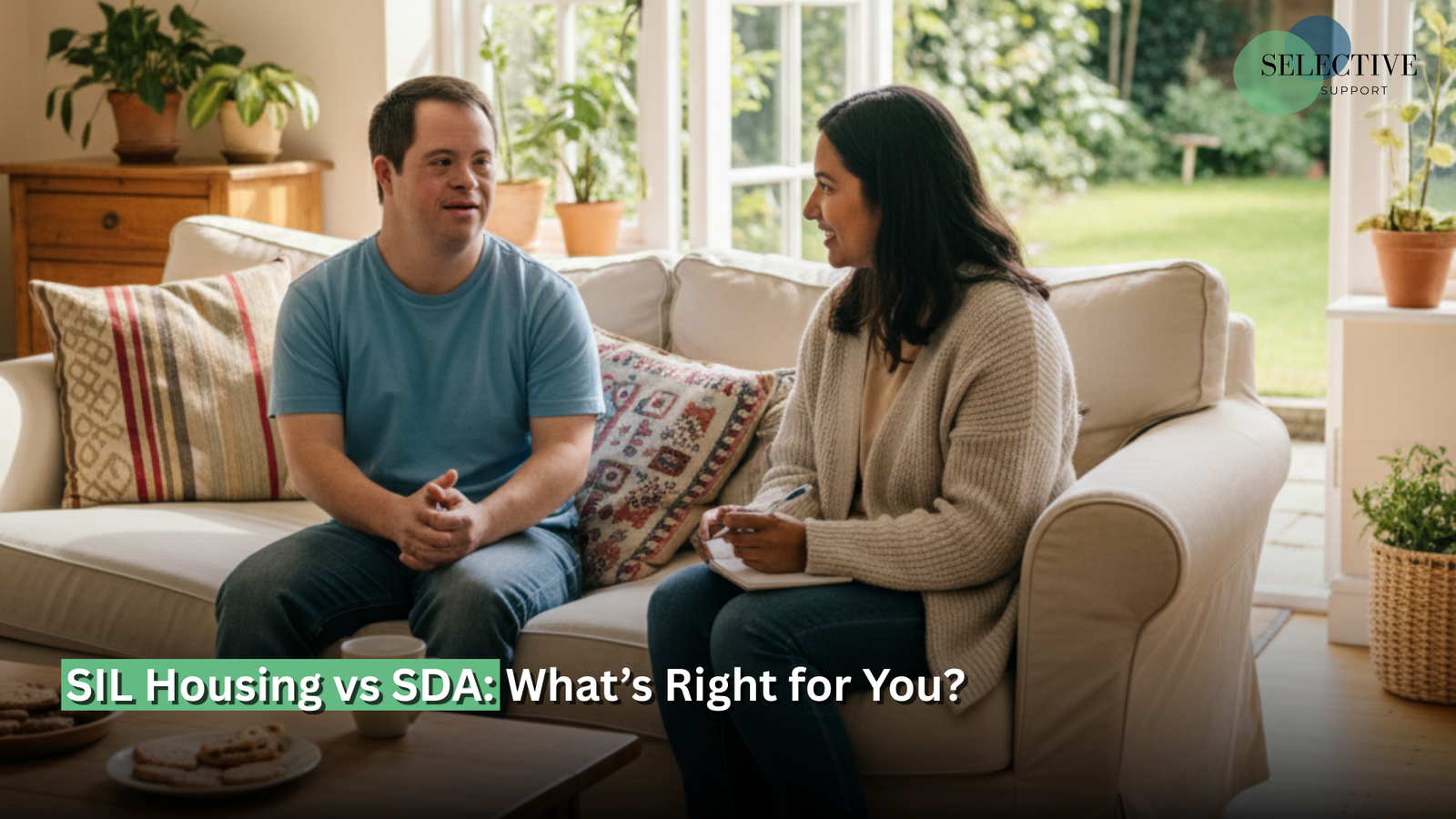SIL Housing vs SDA: 3 Key Differences You Should Know
Ever looked at your NDIS plan and wondered, “What exactly is SIL housing? And how is it different from SDA?” A lot of participants and carers feel confused by these two terms and the difference matters.
Understanding the right type of NDIS housing support can mean feeling more confident, more independent, and more in control of your daily life. Whether you’re figuring things out for yourself or supporting a loved one, this blog will explain the 3 key differences between SIL housing and SDA.
1. SIL Housing and Independent Living Services Offer Ongoing Daily Support
If you’re needing help with everyday tasks but still want to live as independently as possible, SIL housing might be the support you’re looking for. SIL stands for Supported Independent Living, a type of support funded by the NDIS to help you live in a shared or individual home with the assistance you need.
SIL Housing Helps You with Day-to-Day Tasks
SIL is designed for people who need regular help with things like:
- Cooking meals
- Taking medication
- Cleaning and household chores
- Managing personal care
It’s not about the house itself, but rather the independent living services provided inside the home. It gives you the choice and control to live how you want, with support tailored to your needs and preferences.
Whether you’re living with others or on your own, independent supported living through SIL gives you the chance to build confidence, grow life skills, and feel more in control of your day.
SDA Focuses on the Physical Design of Your Home
On the other hand, Specialist Disability Accommodation (SDA) is about where you live, not the supports provided. It refers to specially built or modified homes designed for people with very high physical support needs or extreme functional impairment.
These homes might have:
- Wider doorways and hallways
- Ceiling hoists or assistive technology
- Stronger materials for challenging behaviours
SDA is about safety, accessibility, and structure. Often, SDA and SIL can work together, with the SDA providing the home and SIL offering the daily support inside it.
2. NDIS Funding and Eligibility for Supported Living Accommodation
Are you unsure what you might be eligible for under your NDIS plan? Let’s break down how funding works for SIL housing and supported living accommodation, and what the eligibility process looks like for each.
How SIL Housing Funding Works in Your Plan
SIL is funded through a separate part of your NDIS plan under Core Supports. To access SIL, you usually need to:
- Have a goal in your plan related to living more independently
- Show that you need daily support from a support worker
- Complete an assessment that shows SIL is a reasonable and necessary support
SIL funding doesn’t pay for the rent or property itself. Instead, it covers the independent living services you receive each day.
It can apply to different types of supported living accommodation, like shared homes, apartments, or individual units.
According to the NDIA, approximately 5-6% of NDIS participants have SIL funding in their plans, based on national data trends. With over 739,000 active participants as of June 2025, that’s a relatively small group, meaning SIL is usually reserved for those with significant daily support needs.
SDA Eligibility is More Specific and Requires Approval
SDA is more specialised and comes with stricter eligibility. It’s only available for NDIS participants who:
- Have an extreme functional impairment or very high support needs
- Require a specially designed home to live safely
- Have this need confirmed through detailed reports and assessments
There are only about 6% of NDIS participants who qualify for SDA. That doesn’t mean the other 94% are left out, many participants thrive in standard housing with SIL housing and other supports.
At Selective Support, we take the time to understand your daily needs, housing preferences, and long-term goals. We’ll help you explore the right fit for your support needs whether that’s SIL, SDA, or a combination of both.

3. Day-to-Day Life in SIL Housing vs SDA Homes
What does life actually look like once you’re in a home with SIL or SDA supports? Let’s explore how these setups affect your routine, independence, and wellbeing.
Independent Supported Living in a SIL Arrangement
Living in a SIL home means you have support workers available every day to help you manage daily life. Depending on your needs, this might be:
- A few hours a day
- Overnight support
- 24/7 assistance
The focus is on building routines, independence, and choice. You might live with others who also have SIL funding, or live on your own if that suits you better. Some of our clients at Selective Support find that joining a SIL home helps them:
- Feel safer and more connected
- Get support without feeling overwhelmed
- Build confidence to try new things (like joining a local art group or returning to volunteering)
Specialist Design and Structure in SDA Housing
SDA homes are purpose-built. This means the supported living accommodation you live in might have advanced safety features, technology, and accessibility modifications.
But remember: SDA is about the building itself. You may still need SIL housing to provide the daily assistance you need inside that home.
The structure is important, but the people and supports around you matter just as much. That’s where a provider like Selective Support can help you feel seen, heard, and supported in your everyday life.
“We often remind our clients that SIL and SDA aren’t just acronyms, they shape the rhythm of your daily life. SIL gives you the hands-on help to build independence, while SDA gives you the right space to feel safe doing it. When both come together well, that’s where people really start to thrive.”
Support Coordinator at Selective Support
Your Next Step Toward the Right Home and Support
Still feeling unsure about whether SIL or SDA is right for you? That’s okay. This decision isn’t just about funding, it’s about your safety, comfort, routine, and future.
Let’s recap the key takeaways:
- SIL housing provides daily support to help you live more independently.
- SDA is the specially designed physical home for people with very high support needs.
- You might be eligible for one, both, or a different setup entirely and that’s where personalised guidance matters.
At Selective Support, we help you make sense of your plan, explain your options, and match you with supports that feel right for you. No jargon. No judgment. Just clear, compassionate guidance.
Ready to feel more confident in your NDIS journey? Let’s talk. Book a free discovery call with Selective Support and take the next step toward living life on your terms.
Frequently Asked Questions About SIL Housing and SDA
1. Can I get SIL housing without living in a group home?
Yes. SIL support can be delivered in different living setups, not just group homes. You might live in your own apartment or with one other person, depending on your needs and NDIS goals.
2. What’s the difference between SIL and in-home support?
SIL provides structured daily support in a shared or private home, usually with a rostered team. In-home support can be more flexible or occasional, often used when daily support isn’t needed.
3. Can I choose my own support workers in SIL housing?
In many cases, yes. While some homes have a set team, others allow you to choose or bring your own providers. A good Support Coordinator will help you explore those options.


